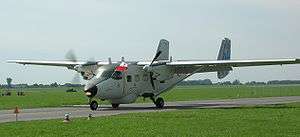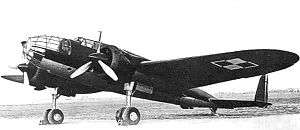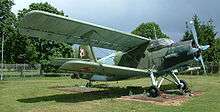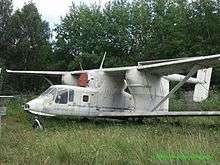PZL Mielec
PZL Mielec (Polskie Zakłady Lotnicze - Polish Aviation Works), formerly WSK-Mielec (Wytwórnia Sprzętu Komunikacyjnego) and WSK "PZL-Mielec" is a Polish aerospace manufacturer based in Mielec. It is the largest aerospace manufacturer in postwar Poland. In 2007, it was acquired by Sikorsky Aircraft Corporation, retaining the brand. Between 1948 and 2014, the company manufactured approximately 15,600 aircraft.[1]
 | |
| Manufacturer | |
| Industry | Aviation |
| Founded | 1939 |
| Headquarters | , Poland |
Number of employees | 1800 |
| Parent | Sikorsky Aircraft/Lockheed Martin |
| Website | pzlmielec.com.pl |

History
Before 1945
Between 1938 and 1939, a factory was built in Mielec, designated PZL WP-2 (Wytwórnia Płatowców 2—Airframe Factory no. 2), which was a division of PZL in Warsaw (Państwowe Zakłady Lotnicze—State Aviation Works), the biggest Polish aviation works, but production was only starting there at the outbreak of World War II. In March 1939 there started manufacturing of the first aircraft—PZL.37 Łoś bombers, assembled from components delivered from PZL WP-1 factory in Warsaw.[1] There were 700 workers at that time.[1]







During World War II, Mielec was occupied by the Germans starting 13 September 1939.[2] During the occupation the factory became a part of Heinkel works, among others producing tailfins of Heinkel He 111 bombers and repairing Junkers Ju 52 planes. There were 5500 workers in 1944.[1] In July 1944 the withdrawing Germans took all the machines and equipment. Mielec was seized by the Soviet Army on 6 August 1944. At first, the factory was governed by the Soviets as a repair works. On 22 July 1945 it was handed over back to Polish control.[2]
1945 to present
The factory in Mielec was renamed to Państwowe Zakłady Lotnicze (PZL) - Zakład nr 1 (State Aviation Works, No.1 plant), and turned into a state-owned factory. At first, it was aircraft repair works and produced mostly non-aviation items, like bus bodies, scales, etc.[2] The first plane constructed in Mielec was a simple trainer PZL S-1, flown on 15 November 1945, of which only 1 unit was built (it was the second plane built in Poland after the war).
The factory in Mielec produced aircraft mostly under license or designed in other Polish bureaus. In 1948 the factory built a small series of 10 utility planes LWD Szpak-4T, designed in the LWD (it was the first Polish post-war series-built plane).[1] In the same year the company started producing licensed Polikarpov Po-2 biplanes under a designation CSS-13, and 180 were built by 1950 (they were also produced by PZL Warszawa-Okęcie). In 1950 also a small series of pre-war Polish Salamandra gliders was built.
In 1949, the factory was renamed, like all Polish aerospace industry at that time, as Wytwórnia Sprzętu Komunikacyjnego – zakład nr 1 (Communication Equipment Factory, No. 1 plant), in short WSK-1 Mielec or just WSK-Mielec.[2] For a short time in 1970-1975 it bore a name WSK Delta-Mielec.[1] In 1975 it returned to a traditional name Wytwórnia Sprzętu Komunikacyjnego "PZL-Mielec" (WSK "PZL-Mielec"), in an honor of the PZL brand.[1] In 1950s there were 2600 workers, a biggest number was 18,000.[1]
From 1950, the factory developed a lot and became the biggest Polish aircraft producer. It was a licensed producer of the Soviet-designed jet fighters MiG-15 (produced as Lim-1), MiG-15bis (Lim-2), MiG-17 (Lim-5), and their Polish-developed variants(the SBLim-1 and 2 trainers and the Lim-6 attack plane).[1] The first Lim-1s were manufactured of Soviet parts in 1952, a full-scale production started in 1953. About 1500 Lims were built by 1964. In 1957-1960 there were also produced 250 Polish-designed piston trainers TS-8 Bies. From 1963 there was produced Polish-designed jet trainer TS-11 Iskra, being a basic trainer in the Polish military aviation. Its successor, designed with a part of PZL Mielec, the PZL I-22 Iryda, appeared to be a failure for different reasons, mostly due to a lack of proper funding, and as such only a small series was built.
The most numerous plane built in Mielec was the licensed Soviet Antonov An-2 utility biplane, produced from 1960 in different variants. 11,954 of these aircraft were manufactured by 2002,[1] mostly for the Soviets, but also used in Poland and exported to other countries. Among them there were 7880 agricultural An-2R, 1640 transport-passenger An-2TP, 1344 transport An-2T, 816 passenger An-2P, 154 floatplanes An-2M, 52 military paratroop transports An-2TD, 44 executive An-2P Lux.[1] From 1984 PZL Mielec became an exclusive producer of the Soviet STOL transport plane Antonov An-28, of which 180 were built.[1] It was subsequently developed in Mielec and in a modernized variant PZL M-28 Skytruck/Bryza, with Western avionics, is offered for the Polish Army, Polish Navy and services abroad, with some success, also as a maritime patrol aircraft.
Apart from a license production, several aircraft were designed at Mielec in the 1950s and 60s, but they did not enter production (e.g PZL S-4 Kania, PZL M-2, PZL M-4 Tarpan). More profitable appeared a cooperation in designing. In 1973, with Soviet aid, Mielec designed the only jet agricultural aircraft in the world, the WSK-Mielec M-15 Belphegor, which was built between 1976 and 1981 for the Soviets. On the other hand, the factory started cooperation with American firms and the result was the very successful agricultural aircraft M-18 Dromader, first flown in 1976 and produced and developed until now (as of 2012). Over 759 were produced,[1] most exported to Western countries. WSK-Mielec also started production of the PZL M-20 Mewa utility plane (licensed Piper PA-34 Seneca), but a small number was built only. Partly basing on the M-20 the factory developed a successful light trainer PZL M-26 Iskierka of 1988, however only seven were built.
Non-aviation production
The factory produced also non-aviation items, like fire engines (1948), refrigerators (1954–1966), Mikrus MR-300 microcar (1956–1960, 1728 built), refrigerator car bodies (1962–1974), TV broadcast cars (from 1965), fuel injection equipment (from 1964), Leyland-licence diesel engines (from 1967), Melex electric utility vehicles and golf carts (from 1970, mostly for export to the USA, later separated as own brand). In 1993 a division Wytwórnia Aparatury Wtryskowej "PZL Mielec" (Fuel Injection Equipment Factory "PZL–Mielec") was separated as a limited liability company.
Present and future
On 19 October 1998, a state-owned factory WSK "PZL-Mielec" was converted into a state-owned company Polskie Zakłady Lotnicze Mielec Sp. z o.o. (Polish Aviation Works), in short: PZL Mielec (not to confuse with pre-war PZL - Państwowe Zakłady Lotnicze).[1] In May 1999 it was certified according to JAR-21.[1] After a fall of export to Eastern Bloc countries, a production volume decreased and there remained 1200-1400 workers.[1]
On March 16, 2007 the PZL Mielec was acquired by the Sikorsky Aircraft Corporation, then a unit of United Technologies Corporation (UTX), today a unit of Lockheed Martin.[3][1] From 2009 it manufactures fuselage sections of the parent firm's UH-60M Black Hawk helicopter and from 2010 it serves as an additional final assembly line for helicopter S-70i Black Hawk.[1]
The circumstances of this transaction and its aftermath were heavily criticized by the Polish military press, suggesting that the price was very low (56.1 million PLN) due to pro-American lobbying. It was also pointed out that the Polish military agreed in December 2008 to purchase 12 unnecessary M-28B aircraft from the new factory owners, for a price two or three times higher than their real value and export price.[4]
List of aircraft
More important aircraft manufactured or designed in Mielec. A date of first prototype flight / serial production start is given ("-" for not flown or not produced aircraft). A number of aircraft built is given when available, according to.[1]
| LWD Szpak-4T | 1-engine, utility / touring low-wing, 1945/1948 | 10 |
| PZL S-1 | 1-engine. trainer and liaison aircraft, 1945/1946 | 1 |
| CSS-13 | 1-engine, multirole biplane, 1948 (licensed Polikarpov Po-2) | 180 |
| TS-8 Bies | 1-engine, military trainer low-wing, 1955/1957 | 229 |
| M-4 Tarpan | 1-engine, trainer low-wing prototype, 1961/- | |
| An-2 | 1-engine, transport and multirole biplane, 1960 (licensed Antonov An-2) | 11,954 |
| Lim-1 | 1-jet engine, fighter, 1953 (licensed MiG-15) | 227 |
| Lim-2 | 1-jet engine, fighter, 1954 (licensed MiG-15bis) | 500 |
| SBLim-1/SBLim-2 | 1-jet engine, trainer (Lim-1/2 variant) | |
| Lim-5 | 1-jet engine, fighter, 1956 (licensed MiG-17) | 666 |
| Lim-6 | 1-jet engine, attack plane, 1961 (Lim-5 variant) | 110 |
| PZL TS-11 Iskra | 1-jet engine, military trainer, mid-wing, 1960/1963 | 419 |
| M-15 Belphegor | 1-jet engine, agricultural biplane, 1973/1976 | 175 |
| M-18 Dromader | 1-engine, agricultural low-wing, 1976/1978 | 759 (as of 2014) |
| M-20 Mewa | 2-engine, multirole low-wing, 1979/1989 (licence Piper PA-34 Seneca) | 21 |
| M-21 Dromader Mini | 1-engine, agricultural low-wing, 1987/- | |
| PZL M-24 Dromader Super | 1-engine, agricultural low-wing, 1987/- | |
| M-25 Dromader Mikro | 1-engine, agricultural low-wing, -/- | |
| M-26 Iskierka | 1-engine, trainer low-wing, 1986/? | 7 |
| An-28 | 2-turboprop engine, light transport high-wing | 180 |
| PZL M-28 Skytruck / Bryza | 2-turboprop engine, light transport / military high-wing, 1984 (developed Antonov An-28) | 90 (as of 2014) |
| PZL I-22 Iryda | 2-jet engine, military trainer, high-wing, 1985/1992 | 15 |
| S-70i Blackhawk | Medium-duty utility helicopter, 2010 | 35 (as of 2014) |
References
- Gruszczyński, J. (2014), pp. 8–10
- Babiejczuk, J.; Grzegorzewski. J. (1974)
- http://www.sikorsky.com/vgn-ext-templating-SIK/v/index.jsp?vgnextoid=00de6eb78fa78110VgnVCM1000001382000aRCRD&vgnextchannel=709f45d57ef68110VgnVCM1000001382000aRCRD&vgnextfmt=default&pressvcmid=5f9dbda862b73210VgnVCM1000004f62529fRCRD
- Hypki, Tomasz, (in Polish) Karmienie nowotworu ("Feeding of a cancer"), Skrzydlata Polska Nr. 1/2009, ISSN 0137-866X, p.4
- Janusz Babiejczuk, Jerzy Grzegorzewski (1974) Polski przemysł lotniczy 1945-1973 (Polish aviation industry...), Wydawnictwo MON, Warsaw (no ISBN)
- Jerzy Gruszczyński (2014) Sikorsky S-70i Black Hawk in "Nowa Technika Wojskowa - Polski przetarg śmigłowcowy", special issue for MSPO 2014 defence fair, ISSN 1230-1655, p. 8-9.